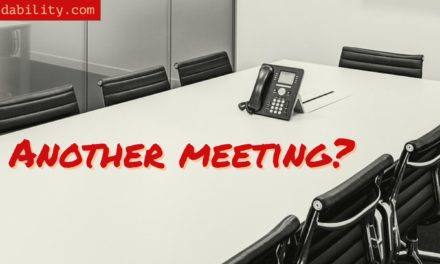Think back to the last meeting you attended. Chances are people wandered in, tossed their notebooks on the table, and leaned back into their chairs with a sigh. It’s the body language of people resigned to yet another useless meeting. We all lament how many meetings we attend at work. Frequently we complain that meetings get in the way of the ‘real work’. Yet, we seldom proactively take steps to make sure those meetings are a good use of time. So how do you make your meeting as efficient as it is effective? We offer 5 ground rules that any team can use to get exactly what they need from their meetings. To make their meetings powerful.
5 ground rules for powerful meetings
Review the objective of the meeting
Although you already sent out the objective of the meeting when you set up the meeting, repeat it before you begin. Most people run between back-to-back meetings. As a result, they may not remember the details of this specific meeting objective. It also reinforces that this meeting isn’t a free-for-all discussion but rather a purposeful means to accomplish the objective. I consider the objective as the ground rule of the ground rules.
Ask team members to start with their conclusions or recommendations
Oftentimes employees believe they need to give background or explanation before they can offer their conclusions or recommendations. This immediately makes the meeting longer. Try asking team members to start with their recommendations related to the objective or what they want from the meeting.
Stay on point with a parking lot
It’s not unusual that as a meeting progresses new information or issues arise that are outside the scope of the original meeting objective. Most teams figure that this new issue is just as important at the original objective. And, since they are already in a meeting the team assumes they should address the new issue in addition to the original. To keep the meeting on point and powerful, record new issues that arise in a parking lot. It may be helpful to state up front that parking lot issues will have a separate meeting.
Pay attention to time: start and end on time
It’s a chronic cycle, meetings start late and then run long. People in the first meeting are then late to their next meeting. That next meeting starts late…and so on. In the meeting invitation for your next meeting, include that the meeting will start promptly. Then actually start the meeting on time. Finally, and most importantly, end 5-10 minutes early. I personally like to sit where I an see a clock when I run a meeting so I can give a warning that the meeting is wrapping up. I might say, “We have about 10 minutes left of the meeting. Let’s begin to close out this meeting by reviewing any action items we discussed.” If your meetings chronically run over assess whether:
- There’s too much to cover in the time allotted.
- The purpose and objective of the meeting is too vague to keep people on topic.
- Attendees are being concise and to the point.
- A parking lot is in use.
Record outcomes and action items
Over the course of the meeting tasks will be assigned and decisions will be made. The problem is that these assignments and decisions are seldom recorded. As a result, no one is sure who was responsible for finalizing that report you discussed. And, the issue decided upon at the last meeting will be rehashed (which may or may not be the same outcome). By implementing these 5 ground rules, your meetings will become more efficient, effective, and powerful. It may take some time before people get into these habits, but it will be worth it.
What are some additional tips to make sure a meeting is powerful? Share your thoughts in the comments below!
Like this post? Consider signing up for our weekly newsletter. Each week you’ll get updates on our newest posts.





